Cement-sand mixture for bricklaying. Choosing a mortar for laying bricks
[ Click on photo
to enlarge ]
Construction using masonry mortars has been known to mankind for several millennia. Traditionally, masonry mixture for bricks consisted of three main components: binder (cement), filler (sand) and water.
Technologies
Winter masonry + Video
As the air temperature decreases, the hardening of the cement mortar decreases, and at zero temperature it practically stops
Plasticizers for masonry mortar
The domestic building materials market has a large selection of foreign superplasticizers based on melamine resins and hyperplasticizers based on carboxylates
Masonry mixture. Choose and use correctly
The quality of the masonry mixture determines the strength, durability, aesthetics and reliability of the entire construction
How to prepare cement mortar for masonry
The main binder in masonry mortar is cement. That is why builders, when preparing a mortar for masonry, most often have in mind a cement mortar
The mortar mixture is dry. We use it correctly
Depending on their functional purpose, the mortars obtained from the mixture are masonry, plastering or facing
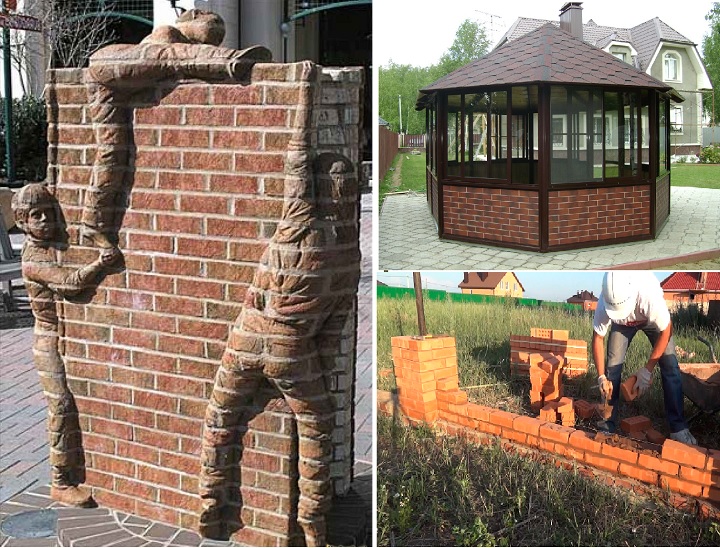 Fireproof masonry mixture - description and application
Fireproof masonry mixture - description and application
A refractory masonry mixture is a semi-finished product that consists of a lining solution or monolithic lining components, which are special filler powders and binders. All this is mixed in advance until smooth and stored in a dry state. This mixture is used for laying fireclay (fireproof) bricks during the repair and construction of fireplaces and household stoves. This mixture is also often used for repairing chimneys and lining boilers and other heating units.
Brick buildings are very durable and reliable. They can last for years. Why years! For centuries. But brick is not considered a cheap material.
After all, to create a small building you will need quite a lot of this building material. And yet, brick houses will never go out of fashion and will not be lost for a long time appearance.
Preparing mortar for bricklaying is the topic of this article.
 Any kind, be it silicate or ceramic, is used to build houses, internal walls in the house, fences, lay out fireplaces, barbecues. The result is aesthetic walls and other brick products that are resistant to various influences.
Any kind, be it silicate or ceramic, is used to build houses, internal walls in the house, fences, lay out fireplaces, barbecues. The result is aesthetic walls and other brick products that are resistant to various influences.
For the strength and reliability of the future structure, it is necessary to make a good mortar, with the help of which rows and individual bricks are held together. There are several types of solutions with different components, and we will talk about this later in this article.
Preparation of mortar for bricklaying
Dry substances and water are mixed and mixed well.
Lime mortars
It is believed that the best mortar is cement mortar.
 A more plastic composition is suitable for brick, which is necessary for the construction of various fences and internal walls. Therefore, you can use a warm lime solution, which is prepared from crushed quicklime and sand.
A more plastic composition is suitable for brick, which is necessary for the construction of various fences and internal walls. Therefore, you can use a warm lime solution, which is prepared from crushed quicklime and sand.
The dry ingredients are thoroughly mixed, and then just add water. After adding water, mix everything well; the resulting masonry mixture should not contain lumps or impurities.
The components for the solution are taken in the following proportions: 1 part lime, 2-5 parts sand.
Cement mortars
In cement mortar, the main components are cement and sand. The proportions of ingredients depend on the brand of cement. For example: 1 part cement and 3-6 parts sand.
Mix the dry ingredients with water until a single mass is formed. First, mix the dry ingredients, and only then add water. But this method is not very good, since even when using different brands of concrete, the solution turns out to be inactive and hard.
Cement-lime mortar
The solution consists of lime and cement. Principle of preparing the solution:
- Lime mass (slaked lime), diluted with water until thick, then filtered;
- Dry cement and sand are combined;
- The dry ingredients are diluted with lime mortar and mixed.
Lime is introduced for plasticity, and was used for masonry of any type of brick.
Simple solution
A typical solution is made from a binder and sand. Sometimes clay is used as a binder, but this solution is used for highly specialized work.
A cement-sand mixture is prepared 1:3. Mix all the dry ingredients, then gradually pour in water. After adding water, the mixture is stirred.
Complex solution
The consistency of the solution should not be liquid, like water.
A complex mix of mortar is considered to be one in which several components and a binder are involved. For example: cement-lime-clay or cement-lime.
When adding clay, the solution does not fall apart and is laid neatly and easily.

For laying bricks on façade walls, plasticizers are added to the mortar. This solution is very economical and is applied to the surface in an even layer.
Ingredient ratio
To prepare the correct solution, you need to calculate the amount of ingredients. For the solution, sand is taken of the middle fraction; the brand of solution can be different, but it is the sand fraction that affects the proportions. For example:
- We use M-500 cement, the proportions will be as follows: 1 part cement to 2/10 lime, take 3 parts sand;
- We use grade 400 cement, the proportions will be as follows: 1 part cement to 1-3/10 parts lime to 2.5-4 parts sand;
- We use grade 300 cement, take 1 part cement to 2/10 lime to 3.5 sand.
All components of the solution must be mixed well.
This example is for a cement-limestone mixture and for a cement-sand mixture.
Solution proportions:
- When using cement grade 500, take 1 part cement to 3 parts sand;
- For cement grade 400, take 1 part cement to 2.5 parts sand.
Useful information
Masonry methods
Bricks are laid according to special rules so that the building structure is monolithic and durable.
To make the solution use cold water without any contamination, its temperature should be 15-20 degrees.
All dosages when preparing masonry mixture must be observed exactly.
- For solid bricks, take a mortar with a mobility of 9-13 cm,
- for hollow bricks take a mixture with a mobility of 7-8 cm,
- in hot weather, take a solution with a mobility of up to 12-14 cm.
Before starting work with bricks and masonry mortars, carefully study all the nuances, select the correct mortar, and prepare it correctly. It’s best to entrust the work to specialists in this field; they must do everything according to the rules. We wish you good luck in your endeavors!
The service life of a building depends not only on the foundation and wall materials, but also on the mounting mortar that holds the bricks, blocks or slabs together. The masonry mixture for bricks must be strong and durable in order to connect and hold structural elements in a single monolith. Violation of technology can lead to irreversible consequences in the form of complete destruction of the building.
Based on the name, it is clear that it is intended for fastening the main building material - brick. Masonry mortar is obtained by combining ready-made dry powder with water or preparing it yourself. If a factory mixture is used, it must be diluted strictly in the proportions specified in the instructions. It is possible to reduce consumption only in one case: to produce the composition immediately, without waiting for loss of plasticity or hardening.
There are several types of mixture.
1. Universal.
Designed for ordinary bricks in civil and industrial facilities. It consists of cement, sand and water. To improve the properties and aesthetic parameters of such a solution, additives are suitable: plasticizers, hardeners, dyes. The name “universal” is applied to several types of mixtures that differ significantly from each other in their characteristics.
A cement-based masonry mortar is used (the proportions depend on its brand), and the filler is sand. To increase viscosity, add a little lime. In this case, it becomes more plastic, fills voids better and does not harden longer. But lime is contraindicated in places with high humidity.
The M 150 cement mixture is most in demand as a universal one. The addition of plasticizers increases frost resistance and reduces water absorption. The combination of low price and excellent characteristics makes it indispensable on construction sites. Suitable for all types of bricks: ordinary, clinker, silicate. White masonry repair mixture for bricks is mainly used when restoring joints on buildings that have stood for several years.

- Clinker brick.
Due to the specific features of this facing product, the installation mixture is slightly different in composition from the universal one. It contains more mineral binders and fillers, which prevents the appearance of shrinkage cracks. Rhine trace is added to the low water absorption brick mixture to help maintain color.
The price of the factory mixture for clinker is higher than the usual one, but experts recommend buying and using it. After all, such a brick itself is more expensive than an ordinary one. A developer who purchased such wall material, but chose a low-quality solution for installation, risks completely ruining the appearance of the building.
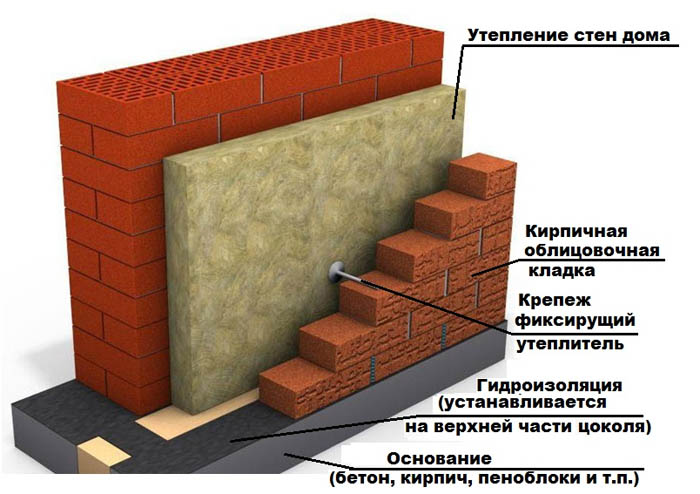
2. Color mixtures.
Modern houses are increasingly becoming “colored”, thanks to pigments. White or dark cement, dyes and polymers are used. A wide range of shades are produced: from white to rich green. Thanks to polymer additives that fix the composition, the seams do not change color under atmospheric influence.
A wide range of colored masonry mixtures for clinker bricks are produced. Fine-grained sand is used as a filler and polymers are added. This ensures plasticity and low water absorption. Various shades of the mixture allow you to combine the color of the brick and seams, embodying design solutions. The consumption will be small if you use it only for jointing.

3. Mixtures for aggressive environments.
Designed for rooms where there is high level temperature, toxicity, acidity. These can be ventilation shafts, chimneys, fireplaces, stoves, combustion chambers. The compositions of such mixtures in the correct proportion contain all the necessary components that can withstand temperatures up to 1690 °C. About 90% are fireproof powders (mortars).
To use, add water and stir until the clay is completely dissolved. Then stand for 3 hours, add more liquid. The required consistency is a stable but plastic mass through which the brick can easily move. Masonry is carried out at temperatures from +5 to +25 °C. The shelf life of the dry factory mixture at a humidity of 60% is unlimited.
GOST standards for different types of compositions
The quality of masonry mortar is described in GOST 28913-98. The standards are as follows:
| Type |
Parameter |
||||
| Compressive strength, MPa | Adhesion, MPa | Filler fraction, mm | Frost resistance, F | Humidity of the dry mixture, % | |
| Universal | 2,5–10* | 0,3 | 3 | 35-75 | 0,4 |
| For facing bricks | 10 | 0,15 | 2 | 25-100 | 0,3 |
| Colored | 15 | 0,2 | 2 | 25-75 | 0,3 |
| Special | 4 | 0,3 | 2 | – | 0,2 |
*For brands from M25 to M100.
How to prepare the mixture with your own hands?
Masonry work in its modern format is a very democratic phenomenon: you can use established traditional methods, that is, mix cement and sand according to known proportions, or you can keep up with progress and buy masonry mortar for bricks in powder form. The first method is more economical in terms of the cost of materials, but at the same time more energy-consuming. However, it is used by thousands of builders.
Special knowledge and skills for self-production no solution required. You will definitely need:
- sieve for sifting sand;
- shovel;
- large trough-type mixing tank;
- container for mixing additives.
The best option is a concrete mixer, but it doesn’t matter if you don’t have one. You can do it yourself with a shovel.
1. First, sift the sand to remove excess (pebbles, clay, plant roots, debris). For this procedure, a metal sieve with 3 mm mesh is used. Some people skip this step and end up with problems instead. There will be foreign objects in the solution, and the time saved on sifting will result in unnecessary consumption of cement.
2. Afterwards, the dry mixture for bricks is prepared. The recommended proportions of laying M400 cement and sand depend on the desired strength grade:
- M25 – 1:5;
- M50 – 1:4;
- M75 – 1:3.
There are special tables that allow you to determine the consumption of components for a solution.
3. The third stage of making a masonry mixture for bricks is direct mixing with water. A third of the liquid is poured into the container and filled with cement sand mixture. After this, the rest is poured out. You need to mix for at least 5 minutes to get a homogeneous consistency without lumps. An indicator of quality is the slow sliding along the shovel.
Powdered components are usually dissolved in water and poured out with the first portion. Liquid plasticizers are added according to the instructions on the package. The consumption of mortar for bricklaying depends on the thickness of the layer and the size of the blocks.
The masonry mixture for refractory bricks is made in the same way. Its proportions: clay – 60%, sand – 30%, cement – 10%. A mixture prepared by yourself reduces costs, because its price is lower than the factory powder. But we must not forget that this solution is conditionally heat-resistant. It contains flammable cement, so the maximum temperature load is 90 ºС. This mixture should be covered with fireproof plaster containing 20% liquid glass.

Average cost
Trade organizations offer to buy ready-made solutions in bags of 25, 30 and 50 kg and in large wholesale quantities. The price depends on the purpose and the availability of additives.
| Manufacturer | Weight, kg | Cost, rubles |
|
Masonry |
||
| Founds Rockform MS110 | 25 | 170 |
| Knauf Cottage | 25 | 120-140 |
| Knauf LM 21 | 20 | 280-300 |
| Monolith | 25 | 140 |
| Perfecta "Linker Thermo" | 20 | 270-290 |
| Quick-mix VZ 01 | 30 | from 520 |
| MASTER HARTZ M-150 | 50 | 150 |
| Volma Dacha | 25 | 220 |
| Braer LM 21 | 20 | 360 |
| KELLE KS801 | 50 | from 550 |
| Perfecta "Linker Standard" | 25 | from 190 |
| Founds Coverplix AC-117 | 25 | 370 |
| SB 200 clinker winter | 380-690 | |
| Quick-mix VK 01 | 30 | from 350 |
| Quick-mix FM | 30 | from 540 |
| SEAMER | 25 | from 250 |
| Baumit KlinkerMortel | 25 | 350-650 |
|
Special |
||
| Plitonit-SuperFireplace | 20 | 290-360 |
| TERRACOTTE, mortar | 20 | 390 |
| TERRACOTTE, chamotte clay | 20 | 390 |
| Founds Putform MS114L | 20 | 350 |
- Features of mortar for bricklaying
- Basic properties
- Requirements for mixture components
- Preparation simple solution with your own hands
- Cement-sand mortar with lime
- Solution with added detergent
- Recommendations and necessary tools
Brickwork is the basis of many buildings. Bricks are used to build structures of various purposes and strength. Proper preparation mortar for bricklaying largely determines the quality and reliability of the entire construction.
In order to build a high-quality and reliable brick structure, it is necessary to properly prepare the mortar.
By changing the composition of solutions, you can influence the parameters brick walls. Various additives can change the capabilities of such a binder. Preparing a mixture for laying bricks is a fairly simple, but very important task. Compliance with manufacturing technology and composition is the key to the strength of the house.
Features of mortar for bricklaying
In general, a brick mortar is an aqueous mixture of a binder and filler, into which additives can be added to impart additional properties. It should be remembered that masonry mortar differs markedly from mixtures intended for other purposes (for example, plaster).
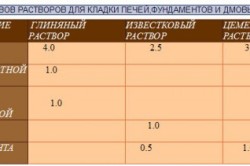
Cement and lime are used as a binder (base), each individually or in combination. The main filler is sand. Clay can be used in combination with it. In addition, plasticizers and other additives can be added to the mixture to increase heat resistance, resistance to moisture, steam, etc. It is quite common to use detergents to increase elasticity.
There are a number of requirements for mortars for laying brick walls. They must have good adhesion to the brick, which ensures reliable adhesion to it. It must be elastic enough to spread evenly over the surface without effort and fill in any unevenness in the brick. It is important that the mixture, after hardening, has high compressive strength. The drying time of the solution should allow it to be used. In addition, additional conditions include thermal resistance and moisture resistance.
An analysis of the use of different binders shows the following. Lime mortar has high elasticity and good thermal insulation properties, but has low mechanical strength. It can only be used in minor buildings - fences, light outbuildings. Cement mortar has increased mechanical strength, excellent adhesion to brick, but is considered a cold and insufficiently plastic material. Many disadvantages are eliminated by using cement-lime mortar, which is quite strong and elastic. It is widely used in the preparation of mortars for bricklaying.
Return to contents
Basic properties
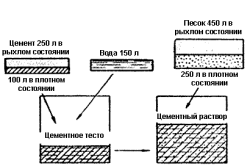
Solutions have their own brands, which can be assigned even to those options that are prepared by hand. It is customary to fix the brand in the following form: for example, M50 is a solution with a compressive strength of 50 kg/cm³. The most widely used options for bricklaying are M10, M25, M50 and M75. Solutions M100 and higher are used in particularly durable structures. You can carry out a strength test yourself - a cube of mortar with a side of 7 cm is subjected to compressive load after 28 days of drying.
An important standardized parameter is mobility. To determine mobility, a cone with an angle of 30º and a height of 15 cm, having a mass of 300 g, is immersed in a fresh solution. It is customary to consider mobility according to the depth of immersion of the cone (in cm) for 1 hour. For laying red brick, the mobility should be no more than 13, and for hollow bricks - no more than 8. When building in warm weather, mixtures with high mobility are recommended.
Return to contents
Requirements for mixture components
When preparing a solution, special attention is paid to the quality of the components. The water for the solution should not contain impurities, oils, or dirt. Best results shows well and spring water. If the mixture is prepared in summer, then the water should be cold, i.e. not heated by direct sunlight; and in winter, on the contrary, it needs to be heated a little. The sand used is well cleaned and sifted. It should not contain clay or impurities. Cement determines the basic properties, so it should be checked especially carefully. When purchasing, you should ensure that the packaging has not been damaged. Cement that has been stored in a humid atmosphere is unusable. Lime should be used in slaked form. You can use almost any detergent - shampoo, washing powder, etc. Cleaning agents alone should not be used.
Return to contents
Making a simple solution with your own hands
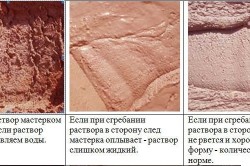
The simplest mortar for bricklaying is an aqueous mixture of two components (cement or lime with sand). In the construction of houses, a simple cement-sand mortar is used. It is prepared in the following proportion: one part cement to 3 parts sand. This dry mixture is loaded into a tray-type container (with an increased area) and mixed thoroughly. When the mixture acquires a uniform gray color, add water little by little with constant stirring. The mixture should acquire a viscous consistency that allows it to be applied to the surface; at the same time, do not be too liquid. The last condition can be easily checked by tilting the container 40º - nothing should spill out.
If the question arises about how to prepare a mortar for laying bricks of different strengths, i.e. different brands, you should change the ratio of components. It has been determined in practice that the M50 solution is obtained by diluting a mixture of cement (Portland 300 brand) and sand in a ratio of 1:5; M75 – at a ratio of 1:3; M100 – 1:2; M150 – 1:1.5.
Return to contents
Cement-sand mortar with lime
When you need to decide how to prepare a solution with increased elasticity, it is worth adding slaked lime. This solution will retain its plasticity for up to 5 hours. It is undesirable to use this solution in the basement part outer wall at high soil moisture. The recommended mixture is the following ratio of cement, lime and sand: 1:1:4 (based on the use of Portland 400 cement), which corresponds to grade M75. For brand M50 this proportion will be 1:0.5:4.5.
The solution is prepared as follows. First, lime dough is prepared - a mixture of lime and sand is diluted in water with stirring to the consistency of thick sour cream. Then the cement is mixed with lime paste with the addition of water with constant stirring.
Choosing a dry mixture for bricklaying
An integral element of the solution for brickwork, is the cement contained in all types of mixture. Based on the conditions in which the work is carried out, it is possible to add clay, lime, and gypsum.
Types of solutions
The following types of building mixtures are distinguished:
- cement – increased degree of rigidity and strength;
- cement-clay – clay introduced into the solution is thoroughly crushed and cleaned of impurities;
- cement-lime – good adhesion and high degree of plasticity. To obtain a solution, mix the cement-sand mixture with lime milk;
- limestone – low degree of strength, increased fragility. They are used exclusively in low-rise construction.
Color mixtures
When work is carried out with facing material, colored masonry mixtures for bricks are used, which have certain advantages. The solution consists of inorganic substances with a fine-grained structure, water and filler.
The composition may look like this:
- lime;
- cement;
- water;
- colored filler.
Mostly this ready mix made from white cement diluted with mineral dyes, the basis of which is iron oxide, added in a volume of 8% of the total mass.

PEREL color mixtures
An example of such a product is the Perel mixture, consisting of the following components:
- cement M500 – helps reduce the release of salts, which makes the structure stronger, maintaining the integrity of the structure;
- sand (fractional, washed) – eliminates the ingress of clay and foreign impurities, leading to cracking of the building;
- pigments (mineral, colored) – provide resistance to atmospheric factors and give the structure the necessary aesthetic characteristics;
- polymer additives – provide strength and water resistance.
Cement mixtures
A widely used cement mixture for bricklaying is made from the following components:
- slaked lime;
- cement;
- water;
- sand.
The solution is made by mixing all the dry components in the following proportion: 5 parts sand, 1 part lime, 1 part cement. The ingredients are thoroughly mixed and then water is added to them. Increased plasticity can be given to the mixture by adding washing powder.
Water is added in doses, since the solution loses its functions after 2 hours. It is necessary to prepare water in small portions, continuously stirring the solution.
Dry white solutions

White masonry mixture for bricks
Especially for the facing material, a white masonry mixture for bricks is used, which has excellent aesthetic characteristics. An example of such a material is the dry mixture Rastvoroff KS 111.1. Water absorption by this composition is carried out in a volume of 3 – 10%.
The product has the following technical characteristics:
- grain size – 2.5mm;
- volume of water in solution – 0.18 l/kg;
- consumption – 1.6kg/m2.
The initial mobility of the mixture is maintained for an hour. The open time is at least 15 minutes, and adjustments can be made in 10 minutes. This dry mixture for bricklaying has a water-holding capacity of 98%; when working, the seam should not be thicker than 20mm. The solution has a compressive strength of about 10 MPa, and the level of its adhesion to the surface reaches 0.5 MPa. This mixture has good frost resistance, reaching 35F, while this indicator in the contact zone is equal to MP325.
White masonry mixture is used for bricks in accordance with certain rules. Initially, dosing and mixing with water is carried out. The procedure is performed in no more than one minute using a mixer. The resulting composition should stand for 3 minutes. Time is necessary for the active dry additives to interact and for the fillers to absorb water. After this, the composition can be used.
Rules for calculating solution consumption
The mixture consumption for brick laying is calculated in several stages:
- calculation of the volume of masonry - the area of doors and windows is excluded;
- the required volume of solution is calculated - it must be taken into account that the calculation is carried out based on the fact that 0.3 m 3 of the mixture is required for 1 m 3;
- The amount of cement is determined based on the obtained proportion.
Example: construction of a one-story building, with walls 15 m long and ceilings 3.4 meters high. It is assumed that there will be 7 windows (1.8 x 1.2 m) and 2 doors (2.1 x 1.3 m). The masonry will have a thickness of 64 cm on the outside and 25 cm on the inside.
Determination of masonry volume:
- determination of the total volume: external walls: (4x15x3.4 – 7x1.8x1.2 – 2x2.1x1.3)x0.64; interior walls: (42x3.4 – 5x2x1.3)x0.25;
- the proportion of aggregate is calculated and binder 4:1;
- the amount of cement is determined.
When choosing which mixture to buy, it is necessary to take into account the operating conditions and further operation. There are cases when a gypsum mixture is more relevant; sometimes it is better to prefer a cement-sand mixture. The main selection criterion should be the optimal price-quality ratio.
 Evidence of falsification of Russian history discovered
Evidence of falsification of Russian history discovered How they live in a monastery: confession of a nun
How they live in a monastery: confession of a nun Hatred towards Putin and his insane corruption is brewing in Russia
Hatred towards Putin and his insane corruption is brewing in Russia